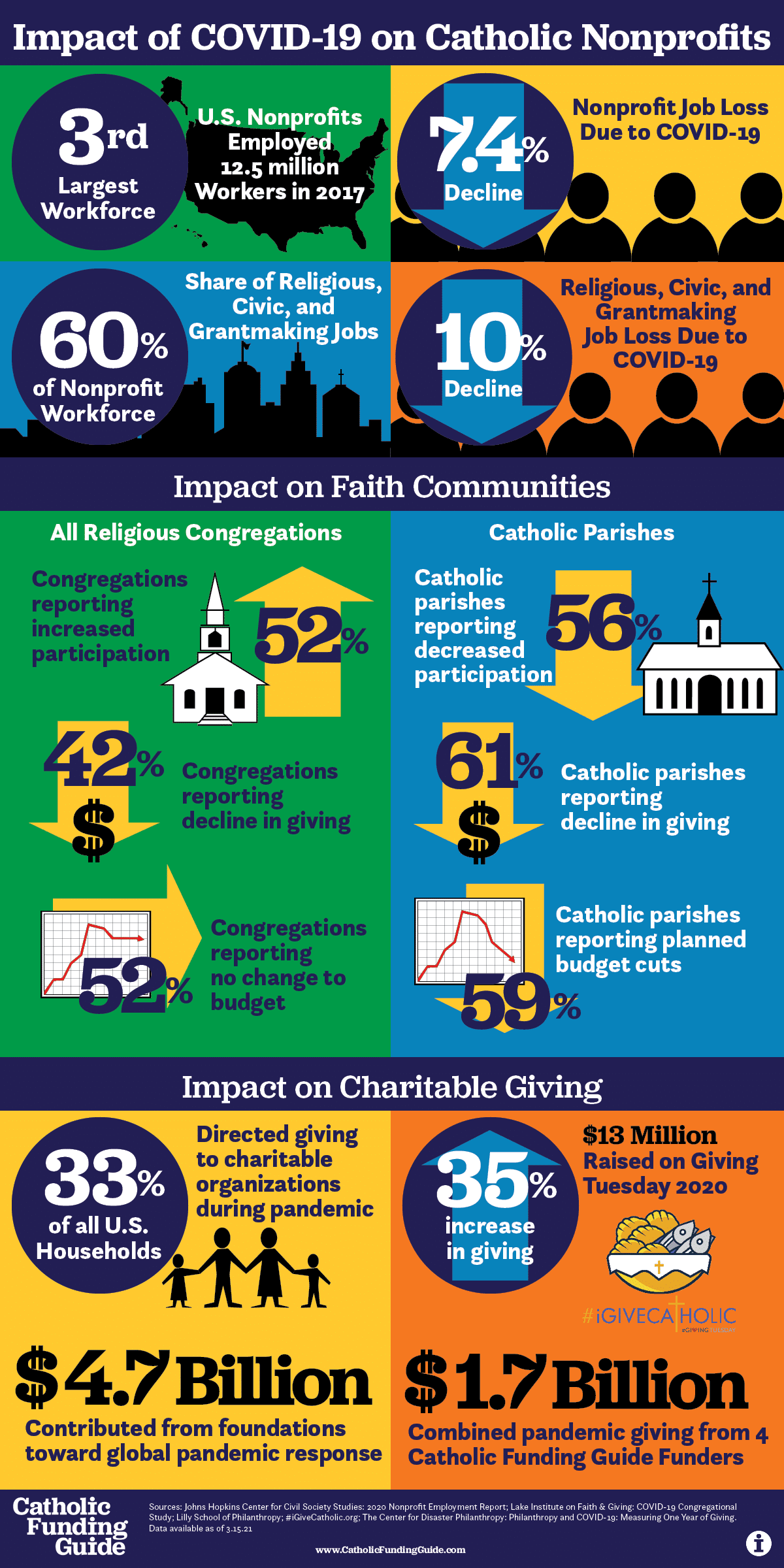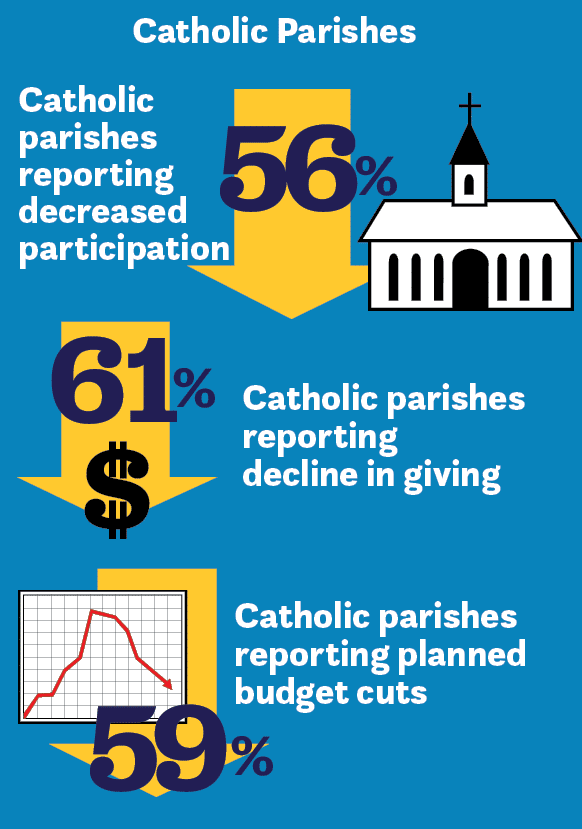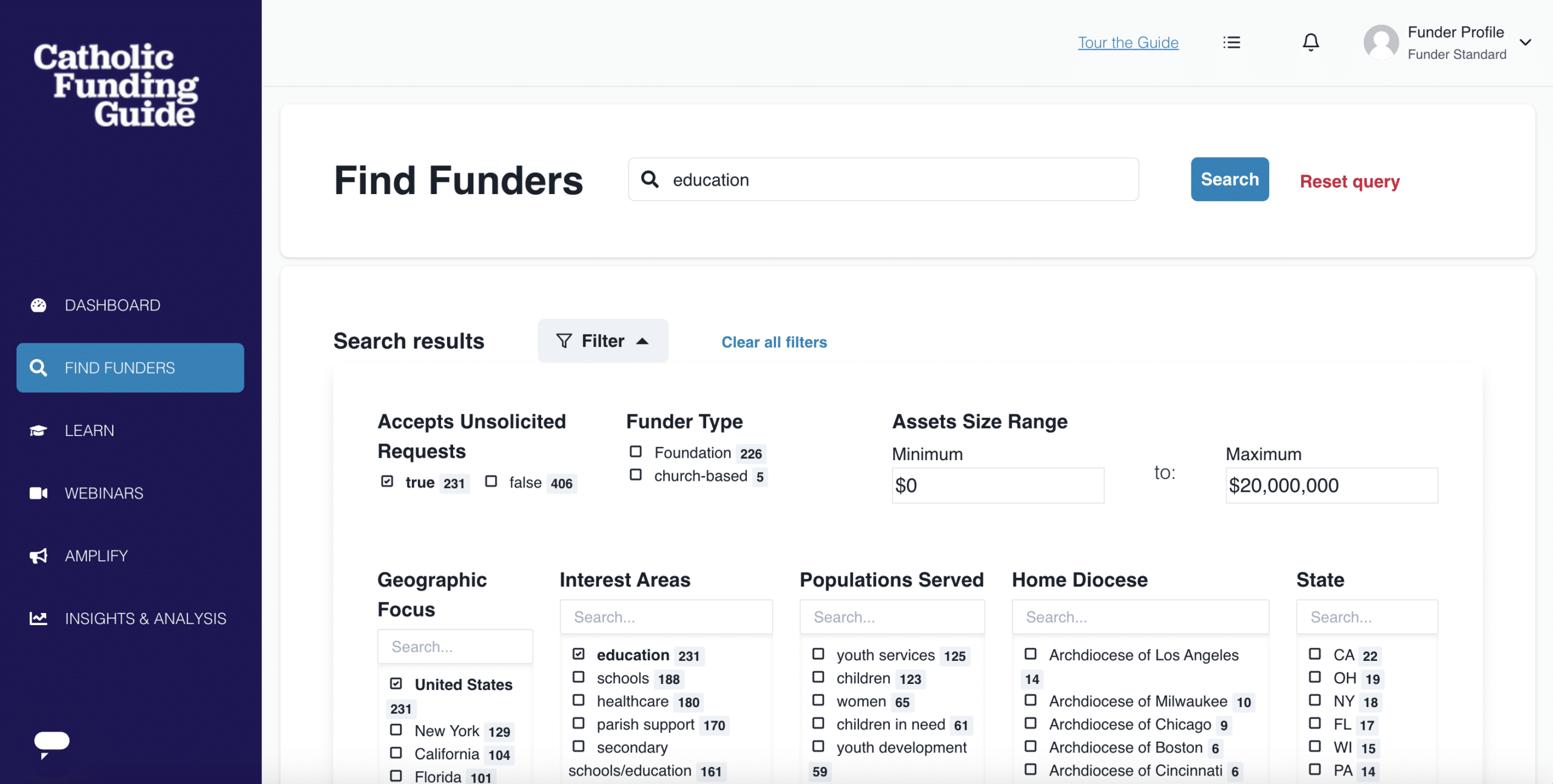A year ago, everyone around the world collectively stepped into a period of “great unknown” as we began to comprehend the anticipated consequences of the global pandemic on all aspects of our lives. As we began 2021 researchers were actively reviewing the data from 2020 to measure the social and economic impacts in order to offer some predictions for the year ahead.
What has the research revealed about the nonprofit sector and philanthropy?
What does the data tell us about our Catholic ministries and programs?
Significance of Catholic Organizations within the Nonprofit Sector
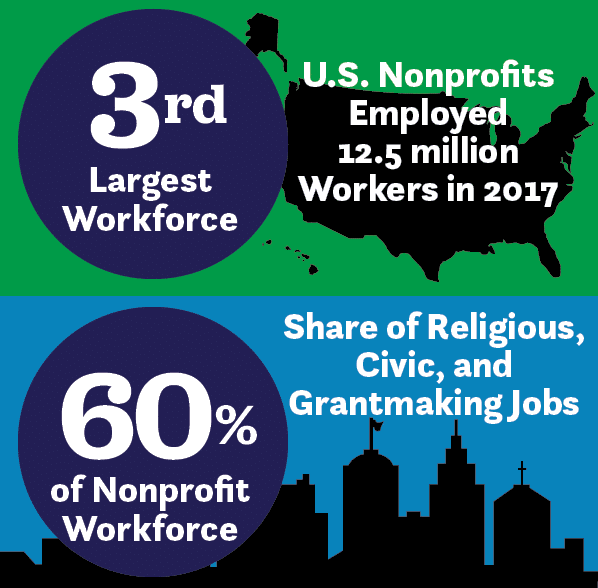
Nonprofits that directly serve the Catholic Church are included in the category of religious, civic and grantmaking organizations that comprise about 60% of the nonprofit jobs in the U.S., according to the 2020 Nonprofit Employment Report from the Johns Hopkins Center for Civil Society Studies. The report revealed that prior to the pandemic, America’s nonprofit sector:
- Ranked as the 3rd largest workforce of any US industry sector;
- Employed 12.5 million workers;
- Outpaced for-profit job growth from 2007 to 2017 following the recession.
Other segments of the nonprofit sector where Catholic organizations have a significant presence are education, healthcare, and social services.
Education: Nonprofit workers represent the majority of private (nonpublic) employment higher education at 92% and 84% of K-12 education. Catholic K-12 schools employ approximately 31% of all private school teachers (2017 NCES data). The NCEA recently reported that Catholic schools are employing 142,977 full-time professional staff during the 2020-2021 school year.
Healthcare: Nonprofits represent 84% of private employment in hospitals. Catholic health organizations comprise the largest group of nonprofit health care providers in the nation. According to the Catholic Health Association of the United States, Catholic health care serves all 50 states with more than 668 hospitals and 1,589 continuing care facilities.
Social Services: Although for-profit employment growth has outpaced nonprofit growth in the social services sector since 2007, nonprofits continue to employ 41% of workers in this sector. One of the largest social service agencies in the nation is Catholic Charities USA, with 3,000 affiliates serving dioceses across the country.
Impact of Pandemic on Nonprofit Employment
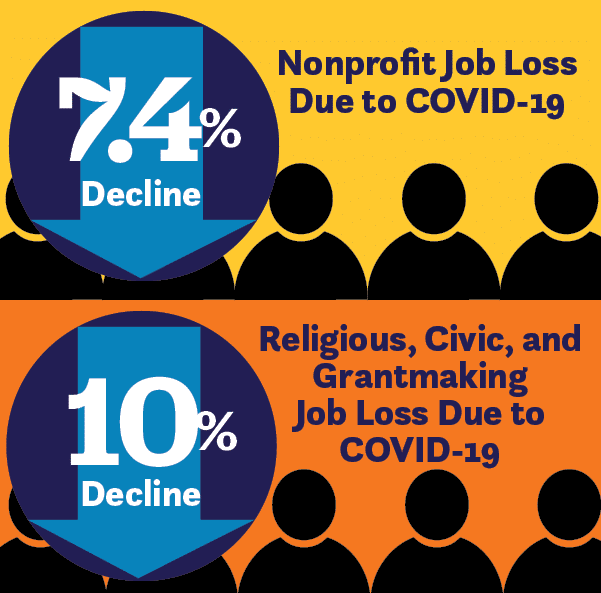
The Johns Hopkins Center for Civil Society Studies has continued to track the impact of the COVID-19 pandemic on the nonprofit sector globally and nationally. The March 2021 update compares pre-and post-pandemic employment levels and has reported that nonprofits have experienced an overall 7.4% decline in workforce. Within each segment of the nonprofit sector, employment changes in February 2021 compared to February 2020 revealed:
- 35% of job losses were in arts and entertainment organizations;
- 6% of job losses were in education;
- 10% of job losses were in religious, grant-making and civic associations;
- 5% of job losses were in social service organizations;
- 4% of job losses were in nonprofit healthcare.
Marginal improvement in employment has been noted as organizations have begun to recover over the last few months. However, researchers anticipate that the full recovery of nonprofit employment is estimated to take nearly 2 years.
COVID-19 Restrictions Challenged Faith Communities
When many businesses and schools closed their doors last spring, so did our churches. The ability for some religious traditions to engage with their congregants through virtual platforms proved successful for most. In September 2020, the Lake Institute on Faith & Giving released the “COVID-19 Congregational Study” which revealed:
- Participation increased in 52% of the congregations surveyed, but 42% reported a decline in giving;
- Catholic parishes reported declines in participation more than other religious traditions, and 61% reported declines in giving;
- 65% of all congregations received Payroll Protection Program (PPP) loans, including 93% of Catholic parishes in the sample;
- 52% of all congregations anticipated no changes to their budget, however 59% of Catholic parishes anticipated that budget cuts would be needed.
The report noted that the challenge of Catholic parishes compared to congregations of other religious traditions may be closely tied to the nature of Catholic worship, stating that the “centrality of the Eucharist to the Catholic mass makes an online service more difficult.”
Increased Generosity in 2020
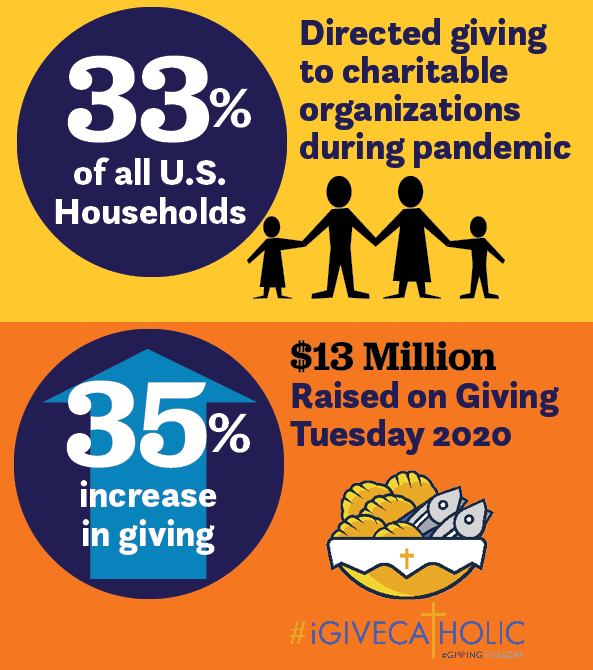
“The pandemic has upended every aspect of our lives, philanthropy included,” said Jeannie Sager, director of the Women’s Philanthropy Institute at the Lilly Family School of Philanthropy. She added that their research identified “a new kind of generosity as people give back to their communities in more imaginative ways, despite facing tremendous challenges.” The institute reported in September 2020 that “one-third of all U.S. households gave directly to charitable organizations, individuals or businesses in response to the COVID-19 pandemic during the initial months of the crisis.”
Within the Catholic community, the Giving Tuesday campaign promoted by #iGiveCatholic raised nearly $13 million in 2020 for 2,600 Catholic parishes, schools and nonprofit ministries – a significant increase from the $7.4 million raised in 2019. Donors to the online campaign were asked, “To what extent has the COVID-19 pandemic impacted your support of Catholic causes this year?” In response, 35% said they increased their giving to meet the increased needs, 53% said they gave at the same level, while only 12% said they had to reduce their giving due to economic strain.
Foundations Responded to Urgent Needs
The pandemic impacted charitable giving from foundations as well, as many grant-making organizations responded quickly with emergency funding and simplified application processes. In an act of solidarity among foundations to provide flexible funding to critical needs, nearly 800 foundations signed a pledge of action through the Council on Foundations.
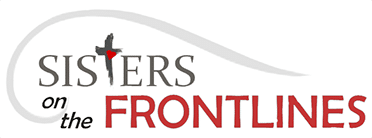
The Center for Disaster Philanthropy’s recent study, “Philanthropy and COVID-19: Measuring One Year of Giving,” reported that independent foundations gave $4.7 billion toward the global response to the pandemic in 2020. Of the top ten independent foundations noted for total pandemic funding, four are listed in the Catholic Funding Guide as funders who support Catholic programs:
- Bill and Melinda Gates Foundation – $1.3 billion
- Ford Foundation – $141 million
- Lilly Endowment, Inc. – $134 million
- The Robert Wood Johnson Foundation – $119 million
The report revealed that the largest share of funding (28%) was awarded to human service organizations, followed by 26% for health causes, 20% for education, 12% for philanthropy and nonprofit management, 11% for public safety and 9% for community and economic development.
What’s Ahead for Catholic Nonprofits in 2021?
Among the myriad of research reports currently available, all studies seem to agree on one point – that we have experienced higher levels of uncertainty than in the past, and we are still living in unprecedented times. The value of any prediction for the future is based primarily on the relatively short history of the pandemic and cannot account for other unforeseen circumstances, such as significant legislative changes or natural disasters. Within this context, the Lilly School of Philanthropy recently published their outlook for charitable giving, suggesting:
- Total giving is projected for a continued increase of 4.1% in 2021 and 5.7% in 2022;
- Giving by American households is projected to increase by 6% in 2021;
- Giving by foundations is projected to decline slightly by 1% in 2021 and then increase by 8.8% in 2022.
- Rates of giving are driven by economic factors such as the growth in the GDP and Standard & Poor’s 500 Index, which impacts giving in the current year for individual donors, and in the following year for foundations.
5 Tips to Assist Your Nonprofit’s Recovery from the Pandemic
-
Online and virtual platforms will continue to be critical to cultivating new individual donors.
If your organization received a significant portion of your operating budget in the past from “in-the-pew” fundraising campaigns in parishes, consider other ways to reach these donors through direct mail, email marketing and social media to lead prospects to give online or by mail. Virtual experiences and online platforms may continue to be the best option for reaching your donors as a group. A survey of nonprofit organizations noted that 62% realized success through transitioning their fundraising events to virtual events, according to the report, “Fundraising Through a Pandemic.”
-
Build a partnership with major donors.
According to Giving USA, the average giving per family increased by 29% in the category of major donors. These donors are more likely to be as personally invested in the mission of your organization as they are invested in financial support. Sharing open, transparent conversations with these donors may provide opportunities to engage their expertise in mitigating challenges, since they may have experienced similar upheaval in their own business.
-
Never underestimate the power of gratitude.
The Fundraising Effectiveness studies by Association of Professional Fundraisers show that it costs less to keep your current donors than the cost to attract new donors. Expressing your gratitude through personal interactions via phone calls or handwritten letters to engage with your donors individually will leave a lasting impression.
-
Stay connected with grant-makers as partners in mission.
Your relationship with grant-making funders should be approached similarly to major donors. Even when budget limitations may change a funders grant-making capacity, they are often willing to offer non-financial gifts of expertise, knowledge and resources to past, present and potential grantees. Nonprofits should continue to keep grant-makers informed of their needs and to share their impactful stories through contact with foundation staff as well as through other channels of communication. When a nonprofit acknowledges a grant award through social media posts, newsletters, and press releases, they are building recognition for the foundation as well as the nonprofit within their community. When a nonprofit shares stories that demonstrate how their programs impact the community, the funder better understands the return on their investment.
-
Build prospects through the Catholic Funding Guide.
The Guide will continue to serve as a valuable resource with our database of more than 2,000 funders who are interested in supporting the Catholic Church, its ministries and social concerns. New foundations are added to the database monthly to help you expand your prospect list. New resources are also added weekly to the Knowledge Center to help you stay informed on key issues in Catholic philanthropy and nonprofit management.
A Resilient Catholic Community
The story of Jesus’ resurrection reminds us that out of loss and grief we may discover new life and new possibilities. When applied to the crisis of the pandemic, this Gospel story has been lived out through the persistence and dedication of the nonprofit organizations who found new ways to continue to serve people in need, as well innovative approaches to fund those services. As faithful disciples, the Gospel story advances through the generous givers who rose up to meet the increased demands with increased financial support.
A better understanding of the possibilities that lie ahead will help Catholic nonprofits as well as Catholic philanthropists strengthen their mutual support for continued mission fulfillment. May the words of Saint Katharine Drexel, patron saint of philanthropy, inspire us to persist with hope: “If we wish to serve God and love our neighbor well, we must manifest our joy in the service we render to him and them. Let us open wide our hearts. It is joy which invites us. Press forward and fear nothing.”
Download Infographic: Impact of COVID-19 on Catholic Nonprofits
